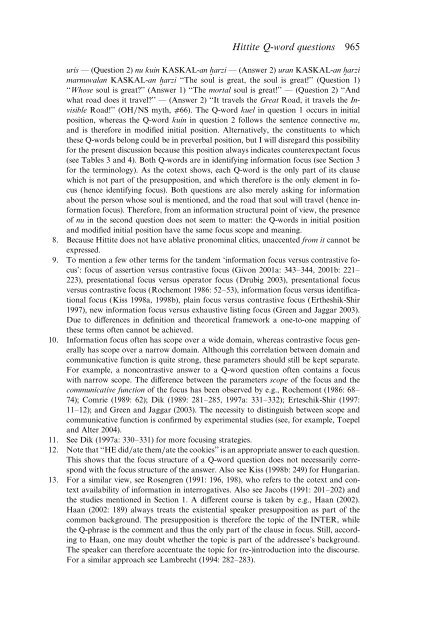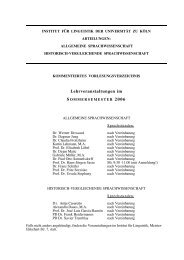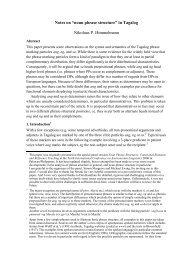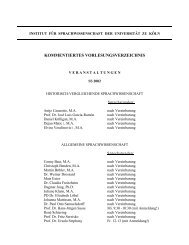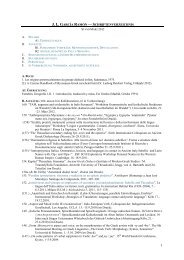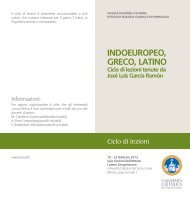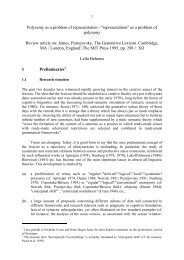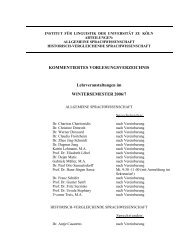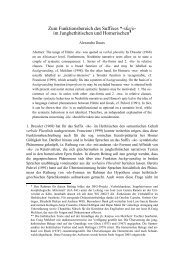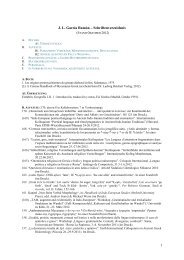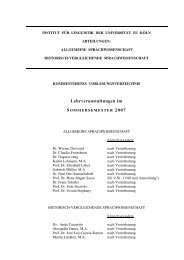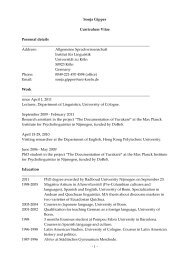Topics in Anatolian Historical Grammar Prof. Dr. H. Craig Melchert
Topics in Anatolian Historical Grammar Prof. Dr. H. Craig Melchert
Topics in Anatolian Historical Grammar Prof. Dr. H. Craig Melchert
You also want an ePaper? Increase the reach of your titles
YUMPU automatically turns print PDFs into web optimized ePapers that Google loves.
Hittite Q-word questions 965<br />
uris — (Question 2) nu ku<strong>in</strong> KASKAL-an h˘ arzi — (Answer 2) uran KASKAL-an h˘ arzi<br />
marnuwalan KASKAL-an h˘ arzi ‘‘The soul is great, the soul is great!’’ (Question 1)<br />
‘‘Whose soul is great?’’ (Answer 1) ‘‘The mortal soul is great!’’ — (Question 2) ‘‘And<br />
what road does it travel?’’ — (Answer 2) ‘‘It travels the Great Road, it travels the Invisible<br />
Road!’’ (OH/NS myth, a66). The Q-word kuel <strong>in</strong> question 1 occurs <strong>in</strong> <strong>in</strong>itial<br />
position, whereas the Q-word ku<strong>in</strong> <strong>in</strong> question 2 follows the sentence connective nu,<br />
and is therefore <strong>in</strong> modified <strong>in</strong>itial position. Alternatively, the constituents to which<br />
these Q-words belong could be <strong>in</strong> preverbal position, but I will disregard this possibility<br />
for the present discussion because this position always <strong>in</strong>dicates counterexpectant focus<br />
(see Tables 3 and 4). Both Q-words are <strong>in</strong> identify<strong>in</strong>g <strong>in</strong>formation focus (see Section 3<br />
for the term<strong>in</strong>ology). As the cotext shows, each Q-word is the only part of its clause<br />
which is not part of the presupposition, and which therefore is the only element <strong>in</strong> focus<br />
(hence identify<strong>in</strong>g focus). Both questions are also merely ask<strong>in</strong>g for <strong>in</strong>formation<br />
about the person whose soul is mentioned, and the road that soul will travel (hence <strong>in</strong>formation<br />
focus). Therefore, from an <strong>in</strong>formation structural po<strong>in</strong>t of view, the presence<br />
of nu <strong>in</strong> the second question does not seem to matter: the Q-words <strong>in</strong> <strong>in</strong>itial position<br />
and modified <strong>in</strong>itial position have the same focus scope and mean<strong>in</strong>g.<br />
8. Because Hittite does not have ablative pronom<strong>in</strong>al clitics, unaccented from it cannot be<br />
expressed.<br />
9. To mention a few other terms for the tandem ‘<strong>in</strong>formation focus versus contrastive focus’:<br />
focus of assertion versus contrastive focus (Givon 2001a: 343–344, 2001b: 221–<br />
223), presentational focus versus operator focus (<strong>Dr</strong>ubig 2003), presentational focus<br />
versus contrastive focus (Rochemont 1986: 52–53), <strong>in</strong>formation focus versus identificational<br />
focus (Kiss 1998a, 1998b), pla<strong>in</strong> focus versus contrastive focus (Ertheshik-Shir<br />
1997), new <strong>in</strong>formation focus versus exhaustive list<strong>in</strong>g focus (Green and Jaggar 2003).<br />
Due to di¤erences <strong>in</strong> def<strong>in</strong>ition and theoretical framework a one-to-one mapp<strong>in</strong>g of<br />
these terms often cannot be achieved.<br />
10. Information focus often has scope over a wide doma<strong>in</strong>, whereas contrastive focus generally<br />
has scope over a narrow doma<strong>in</strong>. Although this correlation between doma<strong>in</strong> and<br />
communicative function is quite strong, these parameters should still be kept separate.<br />
For example, a noncontrastive answer to a Q-word question often conta<strong>in</strong>s a focus<br />
with narrow scope. The di¤erence between the parameters scope of the focus and the<br />
communicative function of the focus has been observed by e.g., Rochemont (1986: 68–<br />
74); Comrie (1989: 62); Dik (1989: 281–285, 1997a: 331–332); Erteschik-Shir (1997:<br />
11–12); and Green and Jaggar (2003). The necessity to dist<strong>in</strong>guish between scope and<br />
communicative function is confirmed by experimental studies (see, for example, Toepel<br />
and Alter 2004).<br />
11. See Dik (1997a: 330–331) for more focus<strong>in</strong>g strategies.<br />
12. Note that ‘‘HE did/ate them/ate the cookies’’ is an appropriate answer to each question.<br />
This shows that the focus structure of a Q-word question does not necessarily correspond<br />
with the focus structure of the answer. Also see Kiss (1998b: 249) for Hungarian.<br />
13. For a similar view, see Rosengren (1991: 196, 198), who refers to the cotext and context<br />
availability of <strong>in</strong>formation <strong>in</strong> <strong>in</strong>terrogatives. Also see Jacobs (1991: 201–202) and<br />
the studies mentioned <strong>in</strong> Section 1. A di¤erent course is taken by e.g., Haan (2002).<br />
Haan (2002: 189) always treats the existential speaker presupposition as part of the<br />
common background. The presupposition is therefore the topic of the INTER, while<br />
the Q-phrase is the comment and thus the only part of the clause <strong>in</strong> focus. Still, accord<strong>in</strong>g<br />
to Haan, one may doubt whether the topic is part of the addressee’s background.<br />
The speaker can therefore accentuate the topic for (re-)<strong>in</strong>troduction <strong>in</strong>to the discourse.<br />
For a similar approach see Lambrecht (1994: 282–283).


